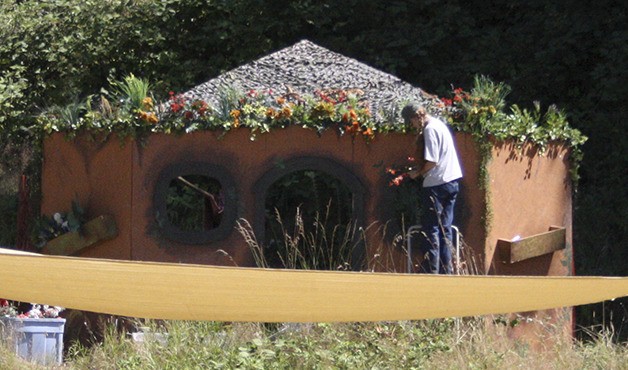In the village of Merriwick, everyone leads a double life. A database manager is also a rags-to-riches noblewoman. An auto parts delivery driver is also a royal ambassador to the Romani. An apartment manager is also a financier to Queen Elizabeth I.
You may not be familiar with the village of Merriwick but, if you’ve driven by Kelley Farm in the past week, you’ve seen actors and volunteers — some of them military personnel from Joint Base Lewis-McChord — building it week by week. While Merriwick is very much a real place to its denizens, it only physically exists for three weekends a year during the Washington Midsummer Renaissance Faire. The Faire begins this Saturday and runs Saturdays and Sundays through Aug. 18.
One week out, the village’s physical structures — such as Castle Gate, Hangman’s Acre and Faerie Landing — were just being raised in the late afternoon of a hard day’s setup. Village construction was moving along smoothly — maybe too smoothly, a volunteer jokingly mused. When work is complete Merriwick will truly be a city within a city, able to accommodate more than half the population of Bonney Lake.
“We can accommodate up to 10,000 visitors a day,” Operations Manager Tracy Nietupski said. “We had 30,000 total over all the weekends last year. I’d love to hit 35,000 this year; I’d love to hit 40,000 for that matter.”
As operations manager, Nietupski is never at a loss for things to do in the lead-up to Faire. She is in constant communication with her volunteers, whether overseeing set-up or making sure everyone involved is hydrated, fed and uninjured. While she’s responsible in part for making Merriwick as authentic to 16th century life as possible, she also ensures its necessary modernities: fire compliance, health compliance, first aid and, of course, toilets.
“We have to use anachronistic stuff in those cases,” she said. “But as far as the show goes, we want this to be as close to a village in 1571 as possible. Most of our performers try to speak as people back then would speak. It was a chivalrous and courteous time. So the queen will walk by and they will all bow and say ‘God save the queen!’ Visitors obviously don’t have to do that, but all of our performers are working to make this an authentic historical experience.”
Merriwick itself has no overarching backstory or historic equivalent.
“It’s a rustic English village, it’s 1571, the queen is visiting and the villagers hold a faire for her,” said Amy Forsythe, the Faire’s entertainment director and the president of the nonprofit’s board of directors. However, many of the performers take on the personas of real historic figures.
“We’re trying to make this period of history real for our patrons,” she said. “Especially for children in school, they study this time and the people who lived in it and it may not seem real in class or on the page. But they come here and they can see how it is people lived and spoke and interacted.”
“I love the reaction of kids at the Faire,” Shere’e Robinson, the financier mentioned earlier, said. “The knighting ceremonies, especially. The Queen is there, she taps them on the shoulders with her sword, they get their certificate stating they’re a knight or lady of the realm. And, to them, it’s 100 percent real.”
Faire performers carry a unique combination of interests: they’re a little bit history buff and a little bit theater nerd in varying balances, with a whole lot of acquired costuming and building skills to flesh out the authenticity.”The day we’re done here, I’m already thinking about next year’s Faire,” Robinson said, echoing a sentiment repeated by everyone who contributed to this story. “I’m researching clothing and historic fabric patterns and whatever else I need.”
“That’s the other thing,” piped in Dan, who requested to be referenced by his stage name Beleg Amrth. “These aren’t just costumes that we make. To last for three weeks out here, they have to be clothing quality.””Yes,” Robinson said. “So when you see me here in costume during Faire, that’s an actual gown I’m wearing.”
None of which is to say Faire isn’t accessible to more novice performers. Kelsey Brannagh is a recent college graduate who became interested in Faire indirectly, through her love of the Lord of the Rings books. She doesn’t have a historic identity yet: she identifies herself as “Household Servant No. 2.”
“She says that, but that has got to be the most important job out here,” Robinson said. “If not for her, we could not do our jobs as the noble court. We couldn’t function.”
Many performers start in household servitude as a matter of pragmatism. It’s a stepping stone: the costumes are typically inexpensive and it’s a relatively simple way to practice the required acting. Faire is a close-knit family, but an open one. Forsythe directs prospective performers to attend improv classes in Seattle to get the hang of playing an unscripted character. And the necessary costuming and building skills can be acquired from other enthusiasts on the internet, Amrth said.
“A lot of the time, we’re happy to meet someone else who’s interested in the same things,” noble performer Jane Nasset said.
The Renaissance Faire runs from 10 a.m. to 7 p.m. the next three weekends. Each weekend will have its own theme: Piratical Plunder, Fantastical Faeries and Her Majesty’s Royal Masquerade on the first, second and third weekends respectively.



